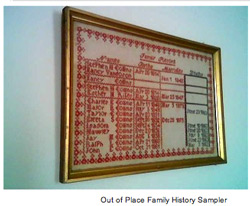The following excerpt is from a very interesting article by Meri Rees in the June 20 edition of the Albany Examiner. Meri writes about finding genealogy documentation that is “out of place.”
Today I visited the old fort in Fort Johnson, New York. The fort was built in 1749 and was the home of William Johnson and later passed on to his son, John. John then later moved to the “big house”, Johnson Hall, when his father died in 1774. Because the Johnsons were considered traitors due to their allegiance to the British, their property and belongings were sold at auction in 1777 after the Johnsons had escaped to Canada. I do not know who purchased the home at auction nor do I know the names of subsequent owners. I do know that Fort Johnson history says that throughout the nineteenth century the house passed through many hands until in 1905, it was purchased by Brigadier General John Watts DePeyster, a Great-Nephew of Lady Mary Watts (wife of John Johnson), and given to the Montgomery County Historical Society.
When visiting, the history of the fort then deals primarily with the Johnson family. Focus on the possessions that belonged to the Johnson family and the restoration of the fort to the way it would have been when the Johnsons occupied it all points to the Johnson family. Imagine my surprise then when I entered one of the bedrooms and found two genealogical samplers hanging on the wall having nothing to do with the Johnsons. One sampler was of a Stephen Collins and his family. The sampler shows two wives and several children. It lists birth dates along with some marriage and death dates. This family information dates back to the mid 1800s. Although records are easily accessible for this family, imagine for a second if they were not. I can just see, in my minds eye, researchers futilely searching for the Collins family; never thinking that the records they searched for would be in a home dedicated to a family named Johnson.
